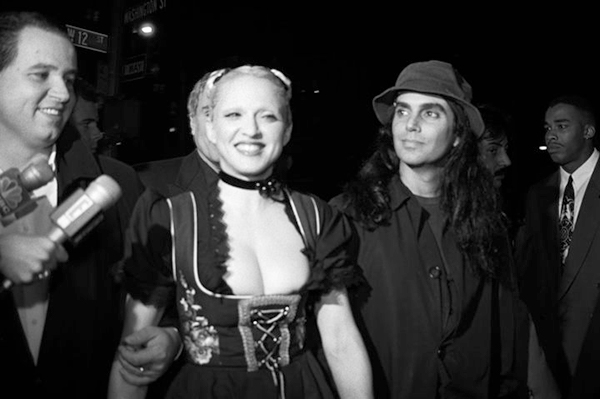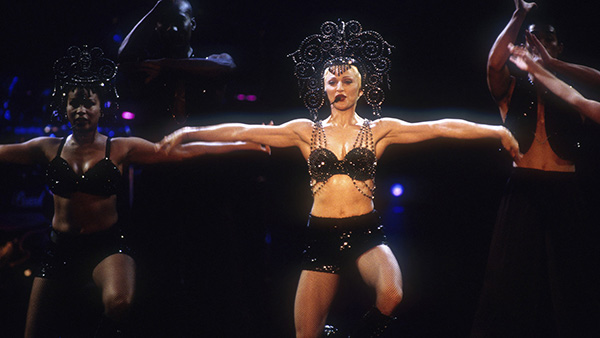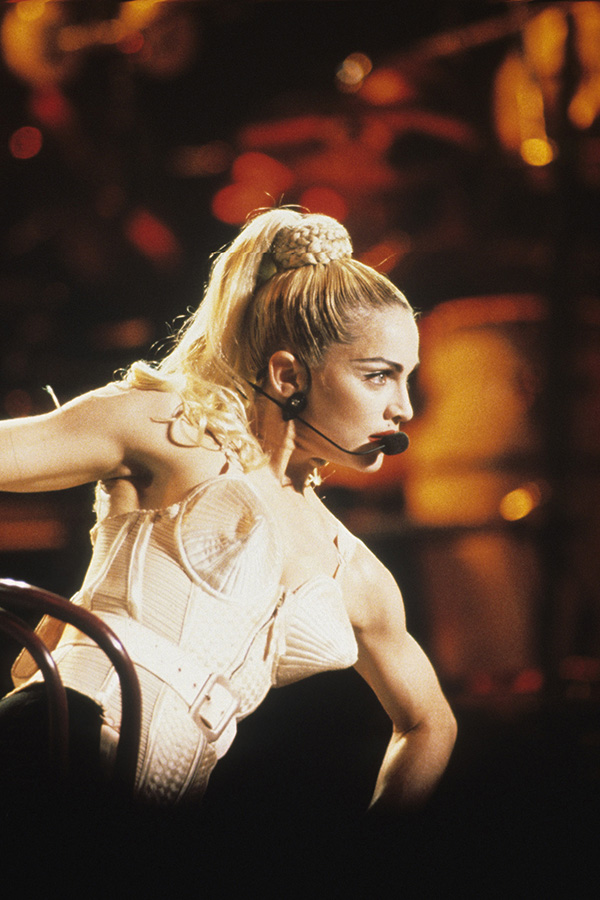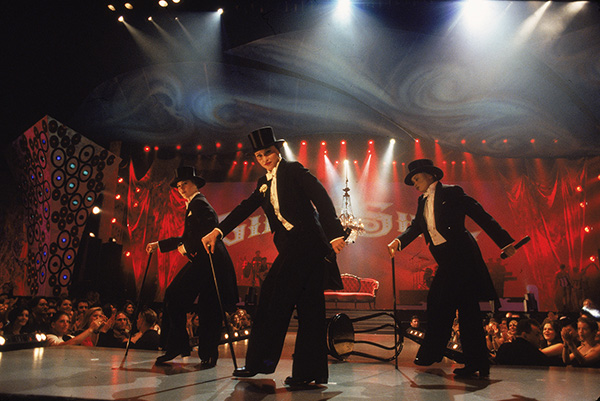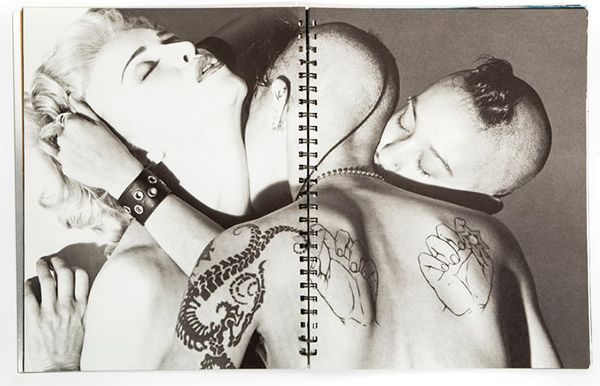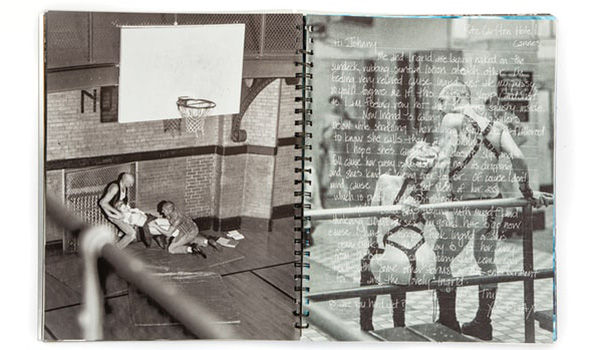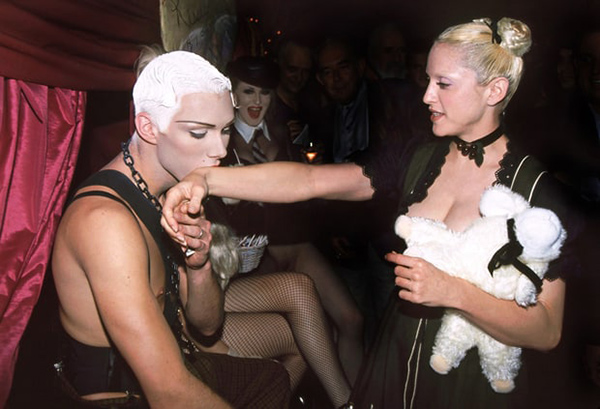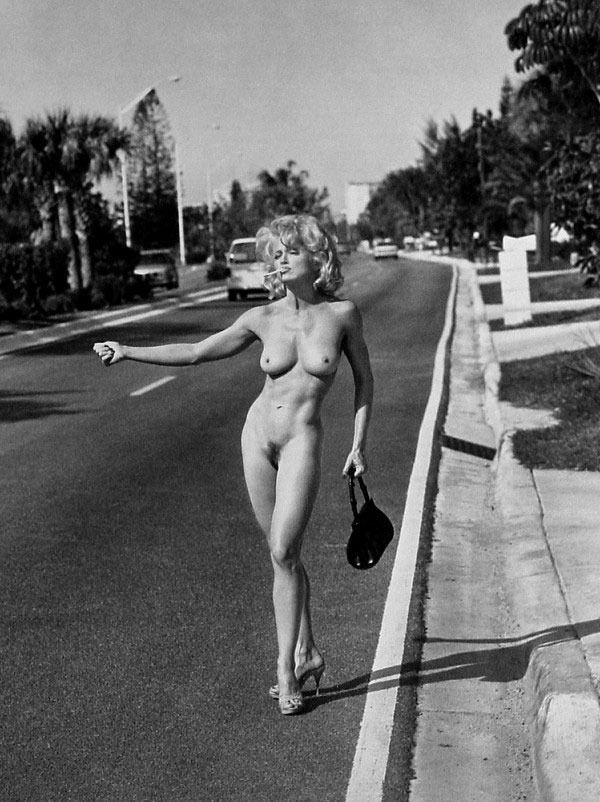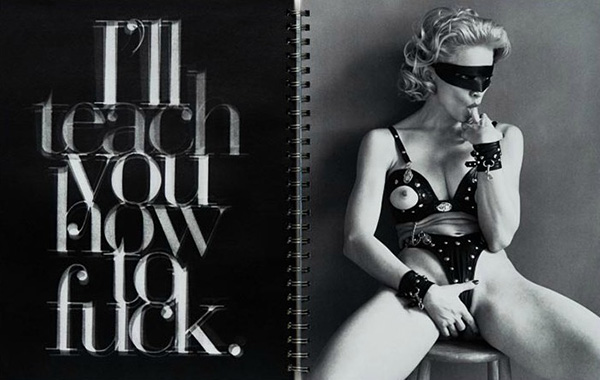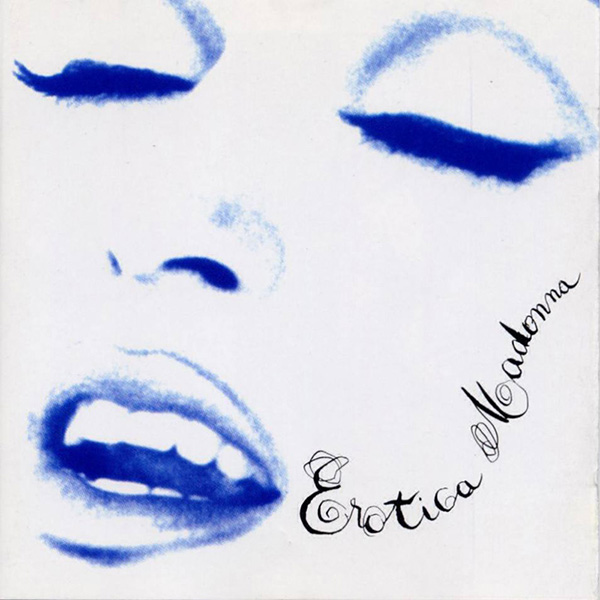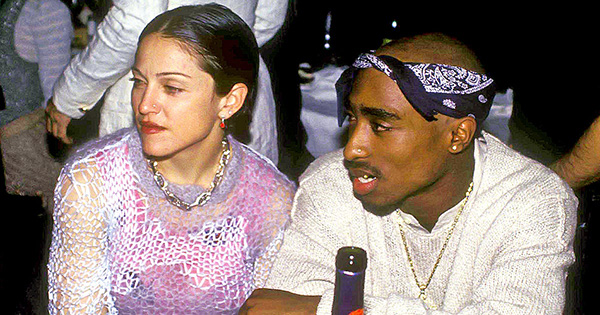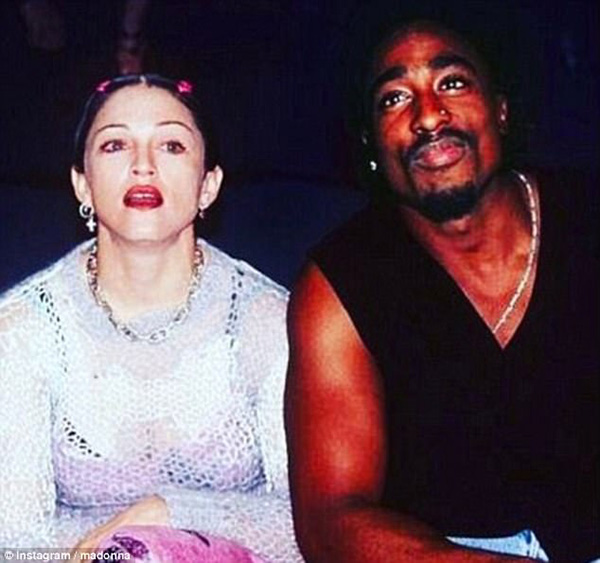| |
Madonna news - Oct. 2017
← Sep. 2017 | Nov. 2017 →
Madonna visits ex-boyfriend Jean-Michel Basquiat's paintings with her kids
Source: W Magazine - 31 Oct. 2017Out of all the mysterious celebrity unions that have transpired, Madonna and Jean-Michel Basquiat's would probably definitely crack the top 10. Back in 1982, the two icons briefly dated, just as they were both on the brink of mainstream fame. While their relationship fizzled out fast, it's stayed the subject of speculation over the past few decades—most recently, as a result of Madonna's latest Instagram posts. Today, the pop artist shared a few photos from a trip she took to visit her late ex-boyfriend's work, joined by her two adopted daughters Stella and Estere, who have become adorable staples on her Instagram.
"Apocryphal. ............JMB ♥️," she cryptically captioned one photo of herself, referencing the biblical term which means "writings or statements of dubious authenticity," perhaps a jab at the many rumors that have stemmed from their union. In the photo, Madonna stands in front of a Basquiat piece that shows her name with an "X" through it.
"Estere Stands stall in front of Fab Five Freddy! 🎵🎤🎶🎨💘💕💘💕," Madonna captioned another photo from her field trip to the Barbican Centre in London, which depicted hip-hop pioneer and Basquiat collaborator Fab 5 Freddy, most famously name-checked by Debbie Harry in Blondie's 1980 chart-topper "Rapture." "Because she knows.....,,,,,,,,,,,#epictimes"
Madonna also shared a GIF of Stella and Estere running in front of another work of art by Basquiat, with the caption, "My Past meets My Present!! JMB ♥️ #legend."
Last year, Madonna commented specifically on her past with Basquiat, telling Interview, “I remember getting up in the middle of the night and he wouldn’t be in bed lying next to me; he'd be standing, painting, at four in the morning, this close to the canvas, in a trance. I was blown away by that, that he worked when he felt moved.” The singer turned beauty mogul also shared some details from their breakup in another interview with Howard Stern, as Artnet News reported. “He wouldn't stop doing heroin. He was an amazing man and deeply talented, I loved him,” she said. “When I broke up with him he made me give [the paintings he gave me] back to him. And then he painted over them black.”
25 years later, Madonna's 'Sex' book is still pop's most radical moment
Source: Huffington Post - 22 Oct. 2017"Sex" and "Erotica" marked the most daring chapter of the singer's career. Spoiler alert: She survived.
Twenty-five years ago, Madonna put the world in a trance with the release of Sex. Well, she put some of the world in a trance: During its first day in stores, the $50 coffee-table book, which lived up to its carnal title, sold 150,000 copies, and it soon topped The New York Times Best Seller list. Of course, because it was mainstream art promoting libidinous pleasure, a puritanical outcry followed. Many critics, cultural theorists and fans alike found the BDSM-themed photo collection scandalizing, even repulsive. In their eyes, Madonna, who already faced accessions of overexposure following a decade of chart-topping provocations, had crossed the line.
Today, Sex is still the most radical career move a pop star has ever made.
During Madonna's imperial phase ― the ephemeral period in an artist's career when everything turns to commercial gold ― she sang about teenage pregnancy, introduced the famous cone bra, burned Christian crosses, simulated masturbation on an arena tour and made a video so prurient that even the youth-centric MTV refused to air it. That was child's play.
The publication of Sex ― on Oct. 21, 1992, one day after its companion album "Erotica" arrived to mixed reviews ― marked the moment Madonna's priorities graduated from making you dance to making you horny. Michael Jackson had been grabbing his crotch for years, and Prince wore an assless pantsuit to the 1991 MTV Video Music Awards, but women were only allowed to push so many buttons. The competing female pop stars of the 1980s couched their sexuality in other aesthetics: punk camp (Cyndi Lauper), androgyny (Annie Lennox), anthems about respect (Janet Jackson), love-hungry wholesomeness (Whitney Houston). For Madonna, however, there was a continuum between "Like a Virgin," the 1984 single that sparked her first brush with controversy, and "Erotica," a concept album about fornication, conceived in the shadow of the conservative Reagan era and the ongoing AIDS crisis.
Sex was an audacious thesis statement, calculated enough to piss people off but seemly enough to maintain artistic integrity. No one today would dare emulate it. Even though desire has grown queerer in the intervening years, the think-piece economy would have a field day with the pornographic imagery, brazen bisexuality and postfeminist authorship sandwiched between the book's aluminum covers.
One of the first photographs, captured in glossy black and white, shows Madonna seated on a stool, wearing bondage gear, breasts exposed. She sucks on one of her fingers while seemingly inserting another into her vagina. Several pages later, a man appears to be eating her out. The rest of the book includes threesomes, men kissing men, women fondling women, dog collars, whips, knives ― everything but graphic intercourse. Throughout, she writes about the pleasure and pain of sex, sometimes scripting letters to a fictional lover named Johnny.
For Sex and "Erotica," Madonna assumed an alter ego, Mistress Dita. As evidenced with "Material Girl" and "Vogue," Madonna always idolized Old Hollywood movie stars, and now she'd turned an entire chapter of her career into character-based performance art. Hers was hardly pop's first alter ego (David Bowie's Ziggy Stardrust being the primo example), but none that have followed (Janet Jackson's varying personas on "Damita Jo," Beyoncé's Sasha Fierce, Mariah Carey's Mimi) are as daring or innovative as Madonna's.
Madonna described the book's contents as "fantasy," but certain naysayers felt Sex was somehow coercing them to adopt her expressions of passion. "Of course, some of us actually like the opposite sex," a female New York Times critic wrote in a review, encapsulating the paradox inherent in the backlash Madonna experienced. "[S]ome of us believe it is possible to have great sex without whips, third parties or domestic pets. [...] Maybe Sex can be a warning about what happens when pop icons become bloated, one way or another."
"Sex was an audacious thesis statement, calculated enough to piss people off but seemly enough to maintain artistic integrity."
Even the reinvention-oriented pop stars who most resemble Madonna ― Britney Spears, Christina Aguilera, Lady Gaga, Miley Cyrus, Rihanna ― have never made political statements as blatant as Sex, if they've made political statements at all. Gaga is a prominent LGBTQ ally, as Madonna was long before such advocacy was commonplace in the entertainment industry, but her music has always centered on dance-floor invitations and commentary about the nature of fame. As Rolling Stone suggested earlier this week, "Erotica" and Sex operated more in the vein of Beyoncé's "Lemonade," also inspired by sociopolitical strife. "Lemonade" was accompanied by a cinematic visual album; "Erotica" was accompanied by a cinematic book co-starring Isabella Rossellini, Naomi Campbell, Udo Kier, Big Daddy Kane, Vanilla Ice and gay porn actor Joey Stefano. (Fashion fixture Steven Meisel took the photos, and Harper's Bazaar creative director Fabien Baron served as the art director.)
Sex and "Erotica" were a one-two punch that could have extinguished Madonna's career. It's not every day that pop singers hitchhike in the nude and live to tell the tale. "This is not a love song," she announced at the start of the track "Bye Bye Baby," a sentiment echoed in the passage that opens Sex: "This book is about sex. Sex is not love. Love is not sex." Such notions, especially in 1992, ran counter to everything a female celebrity was supposed to be: alluring but not dominating, confident but not powerful, prey but not predator. Madonna, forever popular culture's savviest self-marketer, was in full control of the way she displayed her body.
After the hoopla subsided and Sex went out of print, Madonna continued to reinvent herself, most significantly as a spiritually enlightened earth-mother, on 1998′s "Ray of Light," her best album to date. Controversy remained part of her job description. By that point, she'd received so much flak from the media and general public that she could anger without much collateral damage; it's hard to achieve something more daring than Sex.
Madonna is now routinely mocked for remaining sexual as she nears senior-citizen status. It's her checkmate. In the end, that pioneering pluck ― crystallized during her "Erotica" stage ― will define her legacy. As Cher, Diana Ross, Céline Dion and Elton John become nostalgia acts, Madonna maintains the same boundary-pushing persona that, circa 1992, nearly tipped her over the cultural edge. That year, when asked whether she feared being overexposed, she said, brilliantly, "Only at the gynecologist's."
Madonna's 'Erotica' turns 25: An oral history of the most controversial '90s pop album
Source: Billboard - 22 Oct. 2017Twenty-five years ago, Madonna changed. Sure, Madonna was always changing, but with the release of Erotica on Oct. 20, 1992, she fully shed her ebullient '80s pop skin, donned a leather cat mask, and kicked open a rusty back alley door that previous chart-toppers only dared to scratch at.
You didn't need to pick up a copy of her celebrity nude-filled coffee table book, Sex, to realize it. You didn't even need to see Madonna Veronica Louise Ciccone, whip in hand, mugging for the camera in the video for the title track. All you needed to do was press play on the album and let the impossibly thick, libidinous bass line of "Erotica" start vibrating throughout your body. Forty seconds in, the sampled horns of Kool & the Gang's "Jungle Boogie" flare up, but instead of sounding reassuring and familiar, they seem disembodied and eerie. Then, Madonna's latest alter ego addresses you, low and firm: "My name is Dita / I'll be your mistress tonight."
If her earlier work was an invitation to celebrate sexuality without shame, Erotica was a challenge from Dita Parlo – Madonna's unashamed, unflinching dominatrix persona – to witness and perhaps even indulge in society's sexual taboos. Madonna may have addressed the male gaze before, but on Erotica, she wasn't just staring back – she was making the world her sub.
Erotica occupies a watershed place in the pop pantheon, setting the blueprint for singers to get raw while eschewing exploitation for decades to come. For its 25th anniversary, Billboard spoke to the players involved in Madonna's most creatively daring release. Here's what producer-writer Andre Betts, backup singer Donna De Lory, producer-writer Shep Pettibone, co-writer Tony Shimkin and Living Colour bassist Doug Wimbish recall of the writing and recording of Erotica, the insane release party for the LP and book, and the collective societal pearl-clutching that followed.
The seeds of Erotica trace back to 1990's The Immaculate Collection, which included two new songs: "Rescue Me" from Shep Pettibone and his assistant Tony Shimkin, and "Justify My Love" from Andre Betts and Lenny Kravitz. The gospel-house of the former hit No. 9 on the Billboard Hot 100, while the hip-hop-inflected latter – which scandalized the world with its leather-clad, ambisexual music video -- reached No. 1. For Erotica, Madonna reteamed with Pettibone and Shimkin for 10 tracks, and Betts for four.
Tony Shimkin: After doing The Immaculate Collection and "Rescue Me," she let us know she was working on a new album and wanted us to be involved in the writing. Seeing I was a musician and writer and Shep [Pettibone] was more of a DJ and remixer, we collaborated on the writing of the tracks for the Erotica album. We went up to meet with her in Chicago, post-"Vogue," when she was filming A League of Their Own. So we met with her and started to get to work on some music, and sent it to her as we were working our way through it. She would come into New York and have a book full of lyrics and melody ideas and we started working together in Shep's home studio. I believe the first time she was in New York for an extended period, we were working on "Deeper and Deeper" and "Erotica" and "Bye Bye Baby." She's very driven. There's was never a period of feeling it out -- it was diving in headfirst.
Doug Wimbish: I remember Madonna when she used to go to the Roxy before she got really put on. I'd see her at the Roxy when Afrika Bambaataa was down there or [Grandmaster] Flash, and she was down there jamming out. And not just being a spectator, but being engaged in the scene. Madonna's association with the dance music and the gay scene and the hip-hop scene merging in the downtown clubs in New York City, and her coming from Michigan, she got it.... And she knew Dre had something special. A song like "Where Life Begins" is right up his alley. She had a relationship with Dre for his rawness and realness. You gotta be around someone in this business who tells you, "No, I'm not digging that, that's why." And also keep the window open to listen. I think that's what Dre did.
Andre Betts: "Where Life Begins" was the first song we wrote on Erotica. I started working on the track and she started writing lyrics. She called me a few weeks before and asked me over the phone, "I'll be in New York in two weeks, do you want to work?" I'm like, "Yeah of course." She's like, "Find a studio, I don't want to work in a popular studio, I want to be low-key." [The studio I picked] was a hole in the wall for real. She came in, started writing, she's like, "What do you think about this direction and these lyrics?" I was like, "That sounds like something I'd write." Our session got interrupted because a big rat ran across the floor. I'm the only one that got the feet up so at first I didn't think she saw it, and she goes, "Dre, stop being a bitch, it's just a rat." [Laughs] She said, "I'm from Detroit, I'm not worried about a rat."
Shimkin: She really holds fast to a general rule, which is that she's in charge of lyrics and melody, and you're in charge of music. While she has her say in the music end, it's more about the arrangement and how it works with her vocal. She'll still be open to ideas you have about a vocal. One is her dominion, the other is yours, and they don't meet that often, but it's not unheard of to be able to comment either way.
Donna De Lory: She would completely just hear it in her head. Especially when we're doing vocals. Sometimes [backup singer] Niki [Haris] and I would be like, "How 'bout this? How 'bout that?" And she was like, "Nope, this is how it's going to be." And it ended up being great. She was open to other ideas, but I really respected that.
Wimbish: [My first day in the studio], she rolls up and she's got a box with these Playboy magazines from like the '60s. She comes in, Dre sees her and she's chilling, Dre's like, "Yo what's up Mo how you doing?" They start having a conversation. Dre says, "What do you got here in this box." Before she can say anything Dre takes one of the magazines and opens to the center section, is like, "Damn these old babes had some titties back then!" Dre's real straight up and down with her. She's Madonna, she's got that alpha female vibe -- and no disrespect. I'm like "yo, let me see that." She's like, "No, no, I don't want you to see anything 'til you play some bass." Our relationship was broken in based on Dre, that moment and Playboy magazines. Dre's looking at the centerfold, Madonna's doing her Madonna thing, saying, "no, no," and I'm like, "I'm not doing anything until I see some titties and ass."
Shimkin: I was 21, 22 years old at the time. While I'd worked on a lot of major artists' records and spoken to some of them, it can be intimidating at first. When we worked on "Vogue" I didn't speak to her that much, but when we started working in [Shep's] house [on Erotica] and you're there every day, you realize somebody is just who they are. One time, she was asking me if I was done on the computer. She asked me a few minutes later and I was like "not yet," and I started getting more nervous. The next time she asked me, I lost it and I thought it was the end of my career, I said, "I'm not done yet, make some fucking popcorn and I'll let you know when I'm ready." And she was like, "Ah-k." I think she appreciated someone not being a sycophant and kissing her ass, and just being real. It became much easier as time went on. I think she enjoys having people around her who allow themselves to be themselves. She's really no different than what she puts out there to the public in a movie like Truth or Dare. There's not a persona and she doesn't hide who she is.
The first single and title track, "Erotica," set the tone for her album and the Sexbook (a Middle Eastern-flavored version entitled "Erotic" was included on a CD with copies of Sex). But unlike many of the other tracks on Erotica, "Erotica" underwent numerous radical changes during the album sessions.
Shep Pettibone: "Erotica" was four different songs throughout the process. She loved the groove. She would sing it one way, background vocals harmonies and all, then decide to erase everything and start over again. Every version was very good. Shame she made me erase stuff.
Shimkin: The original version of "Erotica" wasn't as slinky and sexy and grimy and dirty sounding until we were in the mixing process of the record, [which was] more toward the final stages. It was experimentation. When we realized it was going to be the first single and started working on the remix, it took on a different, darker vibe. That's when the character emerged, this Dita, when she ad-libbed the speaking parts. Then the character became something that took over.
Pettibone: At one point this was a finely tuned album. She scrapped that and wanted it dirty, murky and not polished.
De Lory: She was more grown up; she was more mature. She had her statements to make and you were there supporting her.
If "Erotica" was a bold sonic departure for Madonna, the second single, "Deeper and Deeper," found her in more familiar disco and house territory – it even featured a lyrical shout-out to her No. 1 hit "Vogue," which "Deeper and Deeper" producers Pettibone and Shimkin also worked on.
Shimkin: The music [for "Deeper and Deeper"] was fairly complete when we handed it to her, with the exception of the middle break bridge section, which took on this Spanish flamenco feel. It had the disco-y feel, the chorus and the melody was all intact, but when we were in the studio transferring the demo elements and adding new elements and getting ready for the mix, I was sitting on the couch in the control room with a guitar and started futzing around with the guitar line in the flamenco guitar section. And she was like, "Yeah, let's do that." Then Shep came up with the idea, "If we're going to go for it, let's go for it – let's add castanets and really take it there." It was an odd thing -- it's not what you normally think of doing in a disco song or club song. But it was a creative process and a lot of fun. [Ed. note: Originally, "Deeper and Deeper" was Shimkin's only credited co-write on the album; he's since been officially credited as co-writer on six other tracks.]
De Lory: All the records with her, you'd show up at the session and you just couldn't wait to hear what she was doing now. By then I'd gotten to know the fans really well, and I thought "the fans are going to love this," especially when we did "Deeper and Deeper." Niki and I loved those songs because we wanted to belt it out. We had so much fun. I remember the brilliance of her vocal arrangements, how she'd wait 'til the end to bring something new in, and you don't want it to fade out, but it is fading.
Shimkin: We were in the process of adding background vocals [to "Deeper and Deeper"]. Most of the vocals came from a Shure SM57 and a quarter inch tape from the demo session, but we did recut some of the vocals. And Shep, while recording, was singing the "Vogue" line over "Deeper and Deeper." She heard it and emulated it, and it just made it. It's happenstance when the melody and key of an original song meld with another one. I think Shep may have suggested [keeping the "Vogue" reference] as a joke and she did it, and we decided to keep it.
Pettibone: Yes [that's what happened].
For as dark as Erotica is, there's actually quite a bit of humor on it, from the cheeky "Vogue" shout-out to the ridiculously boastful "Did You Do It," a rap freestyle set to the music of another album track, "Waiting." It wasn't originally intended for the commercial LP, but it's the reason there are two different official versions of the album.
Betts: What happened with "Did You Do It" was, we used to snap on each other and make jokes. Madonna and I used to talk a lot of shit to each other – a lot. The guys used to always ask me, "the way you guys talk to each other, I know you guys are doing something." They would ask me, "did you do it? Did you have sex with her?" I'm like, "helllllll no." And they're like, "you're lying, you're lying." One day she had to go somewhere, and I'm almost finished with this record, I'm mixing "Waiting." While she was gone, I was just like, "what are we gonna do now?" Everybody's laughing because it's the song "Waiting" and we're waiting for her. And I said, "give me a mic, I'm going to freestyle something." And as a joke, I told them, "guys I need you to sing this part, yell, 'did you do it,' and I'll do the rest." So when she came back she was expecting to hear "Waiting," but I didn't know she was going to come back with the guys from the [Sex] book. So she comes back with four guys in suits, and the song is cued up, ready to play. So I told my engineer, "play," and he goes "uh, no man, this is not the time." And Madonna goes, "stop being a bitch, play the freaking song." He wouldn't do it, so I hit play and sat back down. I'm thinking, "man I don't know how this is going to go down, but it doesn't matter, I'm already paid and this is the last week." So this is going to be one of the worst jokes of all. When I hit play, man, she leaned over behind me and she literally had tears in her eyes and goes, "You are fucking crazy." Not long after that I was with Doug [Wimbish] in Massachusetts working on Living Colour's Stainalbum, she calls me and says, "Dre, I'm using that song on the album." I said "what? Hell no, I'm not a rapper, I didn't even write those lyrics, I just freestyled them," and she's like "I don't care, I think it's brilliant, I love it." Freddy DeMann [her manager] gets on and says, "What if we gave you 75/25?" And I said, "Shit, put that on the record. I don't care what I sound like now." [Laughs] That's really what happened.
Wimbish: Dre helped pave the road to making her explicit.
Betts: Then she called me back to blame my ass: "You know you're the reason I have to have an explicit sticker on my album." I was like, "okay, how you gonna blame me? You decided to put it on." I was like, "You guys want to go through all the trouble for this song to put two different records out?" Because Kmart wouldn't sell records with explicit stickers on them -- they wouldn't even put them in the store.
Erotica wasn't all libido and leather, though. The reflective, regretful "Bad Girl" is one of her most affecting lyrics, and "In This Life" is Madge at her most existential. Meanwhile, songs like "Bye Bye Baby" and "Why's It So Hard" find her experimenting with filtered vocals and reggae, respectively, and on her cover of Peggy Lee's "Fever," she marries chilly club music to a torch song of yesteryear. Taken together, the album shows Madonna's growing willingness to expand her horizons in terms of subject matter and studio techniques.
Shimkin: "Why's It So Hard" is really funny, because it was midpoint writing the record, and we were all a little burnt out. Everybody went on vacation, and Shep happened to go to Jamaica and I happened to go scuba diving in the Cayman Islands, and both places are heavily reggae-based culture. That's what we came back having listened to, so we decided out of nowhere to do a reggae track. And then my vocals appeared on it. Going to see the Girlie Show live and see my vocals lip synced and coming over the loudspeakers at Madison Square Garden was surreal for me.
De Lory: The song "In This Life" was very serious. It was just nice to go into the studio and share our own voices on that, which we could all relate to with what was going on, losing friends to AIDS.
Shimkin: "In This Life" had a really deep personal attachment to her, and [it has an] uncluttered nature to allow her vulnerability to come through. Obviously ["Bad Girl" was] a highly personal lyric. There's a raw element and simplicity that lends itself to a vulnerable vocal and lyric that she puts through. You really hear the emotion in her voice.
Pettibone: [I] never thought about [whether "Bad Girl" was autobiographical]. It was just a good song that I'm sure many people can relate to.
Shimkin: "Bye Bye Baby" was committed to tape with the filtered vocal – it wasn't an afterthought, it was how she heard herself when doing the song. We went to tape with that effect, there was no removing that. Sometimes you apply treatments like that in the mix, but that was committed to tape. There were no restrictions. Everything was tried that was wanted to be tried.
De Lory: When I heard "Bye Bye Baby" and that vocal effect, it had a lot of attitude. There's a bit of girl power in there and that attitude to be able to say that to a guy. You can hear how ahead of its time it was.
Shimkin: We had a song called "Goodbye to Innocence" but that turned into a cover of Peggy Lee's "Fever"; it was something that evolved with the project. There was a song called "Shame" and "You Are the One" [from the sessions that didn't make the album]. I think "You Are the One" fell into what "Thief of Hearts" was feel-wise, and "Shame" probably could have made the record, but it had a happier vibe, it was a little more playful, so I see why it didn't. But they're sitting there in the vaults somewhere. Maybe one day the Basement Tapes will be dug up. Some of it can be found online. People, I think, went into Library of Congress, played demo tapes and somehow copied them. Madonna has such a rabid fan base, they're so interested in knowing everything she does.
De Lory: Niki and I recently did a cover of "Rain," we both love that song and love singing it live [the two still record and perform together]. When I listen to those records I'm so proud of her for being so innovative and being fearless, and to be part of that was incredible. To be on a recording that will be around for as long as forever will be for us humans, I'm so proud. Niki and I were really taken care of, we were paid well and respected and had a great time with Tony and Shep, and I think that comes across on the records.
While Madonna's turn toward transgression wasn't apparent to everyone during the sessions, her collaborators eventually realized the through-line that connected Erotica, her Sex book and the erotic thriller Body of Evidence. At the very least, they were certainly aware of the controversy that engulfed the album upon its release.
Wimbish: She knew how to deliver with shock and awe. The industry had a flow, she got it, and I'm not brownnosing her.
Shimkin: I'm 99.9 percent certain she had this [overarching theme] envisioned ahead of time. It wasn't as obvious to us before when we were doing songs like "Rain" and "Bye Bye Baby" and "Why's It So Hard," but as it slowly came together, it became more obvious as we saw things alongside it. The Sex book, that was being worked on, and she was shooting the [Body of Evidence] movie with Willem Dafoe.
Pettibone: She kept the book very secret from me. It probably would have been a bigger album without all the controversy. But, after 25 years it still sounds good. Better than her newer albums actually. Whatever the matter, I'm still proud of it.
Wimbish: There's all this controversy going on. Here's the deal. From "Borderline" going on, she's a teenage pop idol. And now all the sudden them titties is out. Middle America and everybody else giving their daughters that $10 to buy that record are like, "hey, wait a minute…" Having a record come out with explicit can take sales away from a label. It's all bullshit. People start freaking out and people are starting to cockblock. It's a business we're in. Anybody sees a possibility to shut stuff down, and it starts in the industry itself. But you wouldn't have some of the lanes that are there now without her putting that record out. Fact.
For the book/album release party, Madonna doubled down on the BDSM imagery and threw an infamous party at Industria Superstudio that (to paraphrase Morrissey) would have made Caligula blush.
Betts: Walking in, just showing up out front, is Hulk Hogan standing there trying to get in. He eventually got in. I walk up with my dreads and about three four people, they look at me walk in, I look back at Hulk Hogan like "shit…he could probably whoop my ass." I'm thinking this will be regular party, whatever. The first thing I saw was a naked person suspended in the air on chains, and I say to myself, "oh shit, this will be one hell of a party."
Wimbish: That record launch party she had, oh my God, that was one of the best record release parties ever. By the time I got there it was way past full effect. She had folks behind glass, strippers, and she was like, "this is the way it's supposed to be done." This is no kissing and cuddling – I want to scare you. All y'all know what you're really doing behind closed doors, so let's get it on.
Betts: When I saw the sushi come by with two tits on the tray and the sushi surrounding the tits, I was like, "oh man." Then I saw this big tub of popcorn but the popcorn was moving because this naked woman was underneath the popcorn. I was like, "this is getting crazy now." My friend goes "what's all those doors over there?" So he looks in the first one and goes "oh shit Dre come here," and there's a girl playing with herself. And I go "wow, okay." So then he moves to the second one, there's a couple in there having sex. And he goes to the third one, and it's two guys. And he freaked the freak out, he's like, "oh shit! I've never seen that before." And there was two doors left and he goes "hell no, I don't know what I might see in those doors." The whole point of the party is you didn't know what you're going to see.
Wimbish: The record was one thing, but that party, in my opinion, changed the game.
Betts: She herself didn't do anything crazy that night. She was like, "I've had enough, I want to chill."
Erotica netted four top 40 hits on the Billboard Hot 100, including two top 10s ("Erotica" went to No. 3; "Deeper and Deeper" rose to No. 7), and hit No. 2 on the Billboard 200. It's sold 1.9 million copies to date, according to Nielsen. Even so, the album received mixed reviews, especially compared to the raves she got for Like A Prayer three years earlier. But Erotica has quietly grown in stature over the past quarter century, with critics and artists frequently citing it as a pivotal release in pop and one of her finest efforts. Perhaps the best postscript for Erotica comes from Madonna herself in this 1992 interview with MTV's Steve Blame: "A lot of the things I deal with in my music and the book are, in particular, with the repression that's going on in America right now.…There's a lot of really narrow-minded people. If I can change the way 1/100th of them thinks, then I've accomplished something."
Madonna's 'Erotica,' 'Sex': Why musical masterpiece, defiant book still matter
Source: Rolling Stone - 22 Oct. 2017How the icon's 1992 projects (her own 'Lemonade') tackled homophobia, AIDS hysteria and female, queer desire, and set the blueprint for modern pop.
In 1990, Madonna was as astronomically popular as a boundary-bulldozing, unapologetically bacchanalian performance artist could get. Drawing from Harlem drag balls, "Vogue" went Number One nearly worldwide. The tour showcasing it, Blond Ambition, mixed spectacle with social commentary so sharply that it reinvented the pop concert and yielded the smash documentary Truth or Dare. And that year's The Immaculate Collection, her first greatest-hits set, would eventually rank among the world's biggest-ever albums, despite MTV banning its gender-blurring and cinematically exquisite "Justify My Love" video.
Some loathed this classically trained dancer/DIY provocateur – a megastar peer of Prince and Michael Jackson since her 1984 blockbuster Like a Virgin – with a venom reserved for successful women forging their own path. But for her vast audience, she was nothing less than liberating, and her uninterrupted string of hits defined pop for a decade. What some considered violations of taste made her more commanding: Even the way she toyed with ordinarily unflappable talk show hosts like David Letterman was more rock & roll than actual rock stars.
Nearly everything changed two years later with Erotica and Sex. Released respectively on October 20th and 21st, 1992, the first fruits of her multimedia Maverick entertainment company weren't flops; her fifth studio album, Erotica racked up six million sales worldwide and yielded several hits, while Sex – an elaborate coffee table book created with fashion photographer Steven Meisel and Fabien Baron of Harper's Bazaar – sold out its limited 1.5 million printing in a few days, an unparalleled success for a $50 photography folio bound in metal and sealed in a Mylar bag to evoke condoms. It remains one of the most in-demand out-of-print publications of all time.
But both record and book, despite a few positive reviews, inspired widespread vitriol. "There's nothing erotic about it, unless one finds the idea of a singing death mask sexy." That was Entertainment Weekly's take on Erotica's rendition of "Fever," but it summed up many assessments of the entire album. Others appreciated Sex's forthright presentation of LGBTQ sexuality and S&M even less. "Of course, some of us actually like the opposite sex; some of us believe it is possible to have great sex without whips, third parties or domestic pets," groused not some reactionary macho windbag, but a female film critic for The New York Times.
Why did projects Madonna intended to open minds shut so many down?
As her stardom snowballed through the Eighties and early Nineties, AIDS decimated the scene that helped birth Madonna. Taking music and fashion cues from lower Manhattan's punk rebelliousness and midtown's disco hedonism, pre-stardom Madonna was a fixture in the bohemian underground chronicled by photographer Nan Goldin in her autobiographical The Ballad of Sexual Dependency, a likely Sex influence, along with the severe stylization of Helmut Newton, Guy Bourdin and Robert Mapplethorpe. By 1992, AIDS claimed Goldin's subjects, Mapplethorpe himself, much of the art world (including Madonna's friend Keith Haring), and a growing chunk of Madonna's audience. It also killed and would go on to kill her cohorts, including Blond Ambition dancer Gabriel Trupin. Just as racism and the Black Lives Matter movement shaped Beyoncé's Lemonade, AIDS and ACT UP – the AIDS Coalition to Unleash Power, the direct action advocacy and educational group whose motto was "Silence = Death" – yielded Erotica and Sex.
Madonna previewed both works with the lead single and video for "Erotica," which boldly picked up where "Justify My Love" left off, and is narrated by Mistress Dita, her Sex dominatrix alter ego. "Give it up, do as I say," she growls over gritty funk that combines the clatter of R&B's New Jack Swing with house music's heavy bottom. "Give it up and let me have my way."
But in much of what follows on the LP, the woman behind the vixen doesn't get what she wants: Her relationships fall apart as she awakens from spells cast by deceptive lovers ("Bye Bye Baby," "Waiting," "Words"). Booze, chain–smoking, and anonymous sex can't numb the pain ("Bad Girl"), and a friend steals her man ("Thief of Hearts"). Meanwhile, comrades die ("In This Life") while kindred outcasts struggle ("Why's It So Hard"). "I'm not happy this way," she sings in "Bad Girl." Sensuality was merely part of the picture: Erotica is Madonna's concept album about love and intimacy under the shadow of plague.
In excerpts from his studio diary, Erotica's co-producer/songwriter Shep Pettibone – a skilled remixer who helped Eighties dance grooves evolve from disco to house music – archived the singer's feedback on the album's early slick mixes. "I hate them," she said. "If I had wanted the album to sound like that, I'd have worked with [earlier collaborator] Patrick Leonard in L.A." Instead, Madonna demanded rawness, "as if it were recorded in an alley at 123rd Street in Harlem."
And so her "Vogue" collaborator reverted to the rhythm-intensive immediacy of his remixes as he reworked much of the album until it boomed, banged and sizzled like his increasingly popular remixes: Pettibone's version of "Express Yourself" was the one heard in Madonna's massive video. Instead of composing a radio-targeted album later reshaped for the clubs, Pettibone, together with Madonna, and André Betts – a newcomer who co–produced "Justify My Love" with Lenny Kravitz – made Erotica resemble an alternately party-minded and private collection of 12-inch singles. Even ballads like "Bad Girl" take arrangement cues from club music; in this case, a somber, slo-mo slant on Black Box's piano-pounding house anthems.
Unlike Erotica, which contrasts moods and tempos but maintains a deep and yearning sonic continuity, Sex is varied in style and content. Some shots are straightforward, such as the introductory snaps of Madonna cavorting with two tattooed and pierced lesbian skinheads. The authenticity of her playmates accentuates the fastidiousness of her makeup and the newness of her fetish-wear, which makes Madonna look like a tourist. There's little less sexy than that.
Other photos are open to interpretation: One features four masculine figures standing at urinals with Madonna superimposed in pink. The clash of iconography and grain of the image means it takes some staring to notice one has a hand on another's ass – and even more scrutiny to realize these two apparent dudes are actually women; probably the same butches in the earlier tableau. Here Madonna looks like she's visited that same seedy men's room, and the double exposure insinuates it's on her mind. She's not alone: When bigots obsess over transgender folk in public restrooms, this is what they're imagining. They'd deny the compositional beauty of the image, but there it plainly is, contrasted and highlighted by the sleaze.
Clearly she intended to instigate more than that era's version of the far right: One of the most realistic photos depicts her in a gymnasium under a basketball hoop with books tossed about and a school uniform half off. One guy holds her between his legs, and another guy's hand is poised to explore her naked crotch. There's more than a suggestion of struggle: Only her strained smile signifies consent.
Penned by Madonna, the text also varies in tone. Sometimes she's acting out scenarios likely avoided in real life. Elsewhere she's clearly speaking her own mind, yet with the disclaimer, "Nothing in this book is true," which, to follow her logic, might be a lie. So when she wrote, "The women who are doing [porn] want to do it: No one is holding a gun to their head," critics lambasted the musician. Given that Madonna posed nude in 1978 when she was broke and couldn't stop Penthouse and Playboy from publishing the results in 1985, this statement comes across as atypically naïve.
Because Sex and Erotica launched Maverick and her renegotiated $60 million contract with Time Warner, speculation over the Material Girl's earnings framed nearly every critical analysis. But Madonna's moxie has never been just about profit and fame. As her charities and donations have attested for decades, she also aims to make the world a better place: She just opened a pediatric hospital in Malawi. Back then, she taught soft-core sex ed.
"I think the problem is that everybody's so uptight about [sex] that they make it into something bad when it isn't, and if people could talk about it freely, we would have people practicing more safe sex," she told Vanity Fair at the time. "We wouldn't have people sexually abusing each other, because they wouldn't be so uptight to say what they really want, what they really feel." Maybe that's a little simplistic, but it's genuinely humanitarian. At a time when the straight media essentially characterized all sex as dangerous, Madonna tried to illustrate that it could be safe and stimulating, particularly if we open our minds, free our bodies, and try something besides standard intercourse.
Nowadays, S&M and explicit LGBTQ imagery is never more than a few clicks away, but the internet was in its infancy in 1992: Photos of sexual activity were exclusive to specialty bookstores until Robert Mapplethorpe's headline–grabbing 1989 retrospective The Perfect Moment, which placed S&M and interracial gay sexuality onto museum walls. The resulting controversy – inflamed by North Carolina's obstructionist Senator Jesse Helms and his attempt to prevent the National Endowment for the Arts from funding "obscenity" – engaged viewers in a moral debate. Accordingly, Sex was never about pretty pictures.
Twenty-five years after publication, it's easier to differentiate between Sex's weaknesses and strengths. The sequence with pop rapper Vanilla Ice – Madonna's then-boyfriend – was always tacky, and the section in which she sandwiches herself between hip-hop's Big Daddy Kane and supermodel Naomi Campbell is more stilted than ever. Actress Isabella Rossellini – who appears in a man's suit caressing Madonna and her female friends with an emotional intimacy missing from those celebrity shots – nailed the book's major limitation when she told The Huffington Post in 2014, "Madonna was almost too beautiful, too perfect ... to have that vulnerability or the sense of shock that a regular, more normal, not-so-professional fitted body could convey." No matter how many personas the icon tries on like a pop-art Cindy Sherman, Madonna is Madonna when she takes off her clothes – maybe even more so.
And yet I recognize her intentions. Madonna and I are of the same generation, and before she was a star, we'd party at the same NYC clubs like Danceteria, where her career began. I lost my dad to cancer when I was young just as she lost her mom at age five, and so I know all too well how grieving reactivates that original deprivation, like when my very first lover died of AIDS 30 years ago. After that went co-workers, mentors and friends until the mid-Nineties, when combinations of antiviral medicines slowed and then ultimately stopped HIV's progression for many patients who followed their medication regimen with military precision.
But until then, if you lived in a major city and were gay or an intravenous drug user, sex worker or among their intimates, you were an endangered species. There was no cure, and our government was indifferent. Breaking their silence was essential to our survival and sanity. So when Madonna launched her business with Sex and Erotica, LGBTQ people knew she wasn't exploitative: She was trying to save our lives by politicizing her anger. The frustration of Erotica that critics of the era bemoaned, we applauded because it was our own. Sure, she borrowed some of our fabulousness, but she also gave back plenty.
Accordingly, Erotica is also filled with love. The album's steamiest – and funniest – cut, "Where Life Begins," celebrates cunnilingus with cheeky wordplay, but also sweetness and warmth: Crooning over Andre Betts' hip-hop ballad beats, she beckons the listener, "Go down where I cannot hide," as if to suggest her womanhood is this chameleon's constant truth.
The album's most driving dance track, the hit "Deeper and Deeper," revels in romantic surrender. But LGBTQ people interpret it more specifically about embracing same-sex attraction. "This feeling inside, I can't explain/But my love is alive, and I'm never gonna hide it again," Madonna belts in the concluding verse, hitting that declaration harder than anything in her catalog. Set in a pansexual nightclub much like Danceteria, its video pays tribute to Andy Warhol, here represented by actor Udo Kier – a Warhol graduate who also plays Sex's dungeon master. But it also tips a hat to Madonna's late mentor Christopher Flynn, who introduced the straight-A student and cheerleader to the gay discos of Detroit.
"I always felt like I was a freak when I was growing up and that there was something wrong with me because I couldn't fit in anywhere," she told director Gus Van Zant in Interview in 2010. "But when he took me to that club, he brought me to a place where I finally felt at home."
Her elegiac "In This Life" offers gratitude to Flynn and her late roommate Martin Burgoyne while addressing AIDS head-on. "He was only 23/Gone before he had his time," she sings of Burgoyne; "He was like a father to me ... taught me to respect myself," she croons about Flynn. Like "This Used to Be My Playground," the similarly mournful League of Their Own chart-topper released four months before Erotica but written and recorded midway through the album, this lament reveals the wounded child concealed behind her workaholism. Her fragility makes the singing stronger.
This sincerity spills into "Rain," the sunny single that revived sales eight months after the album's release, and the final track, "Secret Garden." Madonna ponders her feminine essence as a hidden paradise of pleasure, a Garden of Eden, and she reveals insecurities ordinarily concealed, hoping they'll blossom into self-knowledge. "I wonder if I'll ever know/where my place is, where my face is/I know it's in here somewhere," she whispers over a thrusting bass line, a gyrating breakbeat and breezy jazz piano that wanders with her thoughts. When she does sing on the chorus, she's not the ballsy belter of her hits, but an aching, affectation-free spirit waiting for "a place that I can be born," as if the true Madonna hadn't yet arrived.
A quarter century after Sex and Erotica, the era's lingering image of the superstar is the shot of her fully naked – tresses teased and face painted like a Fifties starlet, a cigarette in her lips, and her feet in stilettos – thumbing a ride on a bucolic Florida street. Her nude femininity is perfectly sculpted, yet she exudes the assurance of a suited male bureaucrat. It's the book's most transgressive image, for it presents a woman self-objectifying, calling the shots instead of following them, sharing her amorous dreams with the pluck usually reserved for straight white men. There's no submissiveness; instead, its carnal opposite, flaunted while politicians and religious leaders preached abstinence as the only civilized response to a virus spreading throughout the world and claiming millions of lives. Instead, Madonna cast herself as Hugh Hefner and the Playboy Bunny.
This defiance flipped out men and women alike.
"I divide my career from before and after the Sex book," she told Spin four years later. "Sex was my fantasy, and I made money off of it. That is a no-no."
Her bravado lingered through Body of Evidence, a BDSM-charged thriller, and the Maverick-produced, straight-to-video drama Dangerous Game. Both were widely panned, as well as her 1994 Late Show appearance in which she asked David Letterman to smell her panties, smoked a cigar and said, "fuck" 14 times. In between, she staged her Erotica-centric Girlie Show World Tour, which furthered Blond Ambition's fearless exuberance, but only played three U.S. cities.
Madonna's sound and image then softened substantially with Evita, motherhood and wistful serenades like "Take a Bow" (her longest-running U.S. Number One) before she regained her audacity via 1998's soul-searching Ray of Light and 2000's experimental Music. And although some of her subsequent output has followed trends rather than setting them, she still puts on a rarely rivaled live show by foregrounding her body as the primary site of her art. That was daring in her Erotica/Sex period. Doing that today, as a 59-year-old woman, makes Madonna even more radical. Watch her fiery acceptance speech last December at Billboard's Women in Music shindig if you think she's lost her edge.
"I was called a whore and a witch," she recalled of that epoch. "One headline compared me to Satan. I said, 'Wait a minute, isn't Prince running around with fishnets and high heels and lipstick with his butt hanging out?' Yes, he was. But he was a man. This was the first time I truly understood women do not have the same freedom as men. ...I [felt] like the most hated woman in the world."
Today, Erotica's melancholy desire is all over the boldest substantial pop from Lana Del Rey and Father John Misty to Frank Ocean and Beyoncé, and its dirty house grooves animate chart divas from Katy Perry on "Swish Swish" to underground rappers such as Zebra Katz on "Ima Read." Let's not forget that Grace Jones and Debbie Harry made Madonna possible. But there's an even more direct line between Madonna's unrepentant and emphatically female sensuality – particularly in this incendiary phase – and what followed from Britney Spears, Christina Aguilera, Pink, Lady Gaga, Nicki Minaj, Ariana Grande, Tove Lo and now Cardi B. Without Madonna, modern pop as we know it would be unimaginable. Meanwhile, Sex's provocations have permeated advertising, which was hardly the point. (Meisel's wood-paneled 1995 campaign for Calvin Klein evoked teen porn so brazenly that the Justice Department got involved and CK pulled the ads.)
However, popular music and art are no longer thoroughly defined by a straight white masculine perspective. Nearly everything is more sexualized, and that's not entirely positive, but alpha male artists and submissive female subjects don't dominate as much as they've done for centuries. We've finally hit a tipping point when popular culture is offering more viewpoints and voices: That's why there's a rise in fascism to suppress them. Sex and Erotica's greatest contribution remains their embrace of the Other, which in this case means queerness, blackness, third-wave feminism, exhibitionism and kink. Madonna took what was marginalized at the worst of the AIDS epidemic, placed it in an emancipated context, and shoved it into the mainstream for all to see and hear.
TRIBUTE: Celebrating 25 Years of Madonna’s ‘Erotica’
Source: Albumism - 20 Oct. 2017Happy 25th Anniversary to Madonna's fifth studio album Erotica, originally released October 20, 1992.
When Madonna unveiled her provocatively titled fifth studio album Erotica in the fall of 1992, three and a half years had elapsed since the release of 1989's Like a Prayer, another in a string of consecutive commercial triumphs for Ms. Ciccone and arguably the most critically acclaimed song suite of her career.
In the intervening period, two notable LPs surfaced in May and November of 1990, respectively: I'm Breathless: Music from and Inspired by the Film Dick Tracy, a somewhat pedestrian affair within the context of her career discography, driven largely by the well-deserved ubiquity of the anthemic "Vogue," and the cleverly branded The Immaculate Collection, her first greatest hits compilation which remains her best-selling record of all time. Madonna also proved busy on the silver screen during this time, delivering one of the finest music documentaries ever made in 1991's Madonna: Truth or Dare and co-starring in the entertaining, baseball-themed comedy-drama A League of Their Own released in July 1992. And lest we forget that in April 1992, Madonna co-founded Maverick Records, the Time Warner backed label that would hit the jackpot three years later by releasing Alanis Morissette's massively successful 1995 album Jagged Little Pill.
Remarkably, though not surprisingly considering her workhorse stamina and relentlessly creative spirit, Madonna also found time within her busy schedule to conceive what is arguably her most ambitiously crafted album to date. With Like a Prayer, and albeit a long overdue development, critical perception of Madonna thankfully began to shift away from the predominant and superficial obsession with her persona that had endured since her eponymous debut album arrived in 1983. Instead, many of those who had previously relegated her musical identity and ability as secondary found it difficult to deny the salience and substance of her songcraft, though some of her more adamant detractors remained nevertheless.
"I think it's boring," an emboldened Madonna confided to Jonathan Ross in 1992, when asked about critics not taking her seriously as an artist. "But I think it's a reflection of society. The subject matter I deal with, because it usually is about taboo subjects, people are so frightened of my ideas that they try to undermine my actual talent or any artistic value that may be in any of my work. And just say 'oh she's just doing that to shock people,' or 'oh, look, she's changing her look again, she really knows how to manipulate the media.' But the fact is if that's all I was good at doing, I don't think people would be paying attention to me for this long. I mean, I'm still here."
So it was amidst this growing equilibrium of recognition between Madonna the powerful pop culture icon and Madonna the gifted songwriter-producer that Erotica—the first release to bear the Maverick logo—was born. Though those of us seasoned enough to remember the fall of 1992 will recall that the album's October 20th arrival was very nearly subsumed within the media frenzy that engulfed the accompanying October 21st release of Sex, the companion coffee-table book featuring a series of heavily choreographed images by Steven Meisel that captured Madonna and others in various states of sexual exhibition and exploration. In some cases, Erotica was rendered an afterthought within the inflated brouhaha surrounding the book, as perhaps most glaringly evidenced by the October 1992 issue of Vanity Fair adorned with Madonna on the cover. Comprised of more than 7,600 words in total, the feature article-interview contains just a single reference to the album by name.
In retrospect, it remains unclear to what extent the book's release galvanized sales of the album and vice versa. But 25 years later, it doesn't really matter, as what has endured is the music. Meanwhile, Sex has largely been consigned to the realm of pop culture artifact, never to be flipped through again.
Far less shocking—or stimulating—to the senses by today's more desensitized standards, to say that Erotica was controversial upon its release 25 years ago is an understatement. But the flip side of the coin is that it was an undeniably revolutionary record. The unabashed and forthright way that Madonna redefines sexual identity and power dynamics, deconstructs sexual taboos, and evangelizes sexual freedom was indeed groundbreaking for its time, serving as a much-needed wake-up call for the sexually repressed and repressive, particularly here in the notoriously puritanical United States of America.
Across Erotica's fourteen compositions (thirteen on the LP's edited version), Madonna successfully subverts the antiquated, straight-male dominated dialogue about sex by taking full command of the conversation and delivering a clinic in sexual liberation. With confidence and charisma in droves, she flips traditional gender-driven roles and ethics on their head, blurs the socially-constructed lines between the multitude of sexual identities that exist, and gives mainstream voice and validation to those traditionally marginalized toward the fringes of social acceptance.
And while Erotica is a concept album of the most captivating caliber, whether you share or empathize with Madonna's perspective or not, its thematic thrust all too often overshadows its importance within the context of its creator's musical progression. Though her self-titled 1983 debut Madonna certainly incorporated club-driven inspirations, Erotica is the first of Madonna's long players that found her wholeheartedly embracing the hedonism and influences derived from the dancefloor, an exciting evolution shepherded (pun intended) by co-producer Shep Pettibone that would be further cemented in increasingly glorious ways on subsequent efforts such as Bedtime Stories (1994), Ray of Light (1998) and Confessions on a Dance Floor (2005).
Hip-hop elements and drum breaks also abound across Erotica, thanks in large part to her continued collaboration with André Betts, who co-produced the Public Enemy indebted "Justify My Love" with Lenny Kravitz two years earlier. After finding unprecedented success with long-time collaborators Stephen Bray and Patrick Leonard in the '80s, pivoting to partner with Pettibone and Betts proved a shrewd move, ensuring that Madonna's sound eluded stagnation.
The beat-heavy lead single and album opening title track begins with a needle drop upon a scratchy vinyl surface, signaling the album's DJ-friendliness and promising something more rugged and raw than the polish of Erotica's precursors. A spoken word ode to BDSM and the casting aside of sexual insecurities, an empowered Madonna presides over the ceremony through the adopted guise of the dominatrix Dita, declaring "I'll be your mistress tonight / I'd like to put you in a trance," later reassuring her subject that "If you're afraid, well rise above / I only hurt the ones I love." This duality between pleasure and pain resurfaces two songs later on the sassy sixth and final single "Bye Bye Baby," but from the perspective of fractured love, as Madonna interrogates her lover, singing "This is not a love song / I'd like to hurt you / What excites you? What turns you on? / What makes you feel good? / Does it make you feel good to see me cry? / I think it does / That's why it's time to say goodbye / Bye bye."
Interestingly enough, despite the album's title and the widespread scrutiny and sensationalism it engendered, songs that can be classified as "erotic" in content and tone are actually the exception, not the rule, across Erotica. The cheeky, Betts co-produced "Where Life Begins" certainly fits the title's billing, with its ever-so-thinly veiled innuendo about cunnilingus, with lines like "Let's put what you've learned to the test / Can you make a fire without using wood / Are you still hungry; aren't you glad we came / I'm glad you brought your raincoat / I think it's beginning to rain." Well, alrighty then.
Betts' sonic touch appears on three additional tracks, including "Waiting," a sequel of sorts to "Justify My Love" in its yearning for unrequited love. Included on the explicit version only, its companion composition "Did You Do It?" lifts the same sonic backdrop—replete with the rumbling, Doors sampled bassline that would be heard a year later on Souls of Mischief's "That's When Ya Lost"—and showcases the rhymeplay of Mark Goodman and Dave Murphy. An ode to personal perseverance and survival, the album concludes with the jazz-imbued breakbeat groove of "Secret Garden," which operates as the thematic segue to "Survival," the first track on Madonna's 1994 follow-up album Bedtime Stories.
The album's supreme standout is the second single "Deeper and Deeper," a sublime slice of euphoric disco house that still sounds as fresh as ever, two-and-a-half decades later. An invigorating anthem of sexual awakening, the narrative of "Deeper and Deeper" can also be interpreted through the lens of a man acknowledging and revealing his homosexuality, as perhaps best evidenced in the second chorus ("Deeper and deeper and deeper and deeper / Never gonna hide it again / Sweeter and sweeter and sweeter and sweeter / Never gonna have to pretend") and the song's fourth and final verse ("This feeling inside / I can't explain / But my love is alive / And I'm never gonna hide it again").
Among the three other singles officially released from Erotica, "Bad Girl" leaves the most enduring impression, and not just because of its memorable, Christopher Walken blessed video. A symphonic, drama-filled ballad about a tormented, self-destructive woman who's wronged her lover by succumbing to temptation, the beautifully orchestrated "Bad Girl" reinforces Madonna's penchant for crafting ballads that carry emotional weight without coming across as overwrought, a la her 1986 single "Live to Tell." While the decidedly house-driven, percussive cover of "Fever," originally popularized by Little Willie John in 1956 and two years later by Peggy Lee, is serviceable fare, the polished "Rain" is arguably the only banal and skippable offering among the album's fourteen tracks.
The most painful and poignant moment appears with the somber "In This Life," Madonna's homage to two close confidantes who tragically lost their battles with AIDS—Martin Burgoyne, an artist and her first tour manager, and Christopher Flynn, her ballet teacher and mentor. Reminiscing about Flynn during a 2010 discussion with the film director Gus Van Sant for Interview magazine, Madonna reflected, "Growing up in Michigan, I didn't really know what a gay man was. He was the first man—the first human being—who made me feel good about myself and special. He was the first person who told me that I was beautiful or that I had something to offer the world, and he encouraged me to believe in my dreams, to go to New York. He was such an important person in my life. He died of AIDS, but he went blind toward the end of his life. He was such a lover of art, classical music, literature, opera. You know, I grew up in the Midwest, and it was really because of him that I was exposed to so many of those things. He brought me to my first gay club—it was this club in Detroit. I always felt like I was a freak when I was growing up and that there was something wrong with me because I couldn't fit in anywhere. But when he took me to that club, he brought me to a place where I finally felt at home."
Just as refreshing and rewarding musically as it was for its brave social and cultural conscience, Erotica was, is, and will forever be a fearlessly fierce album that only Madonna could make. No one has ever come close to replicating it and no one ever will. In Vanity Fair's October 1992 issue, Madonna proclaimed, "I'm out to open [people's] minds and get them to see sexuality in another way. Their own and others.'" More than any other album in her prolific oeuvre, Erotica fulfilled her objective and struck a mighty blow to the plague of cultural and moral myopia, in America and beyond.
Madonna continues MDNA Skin promo with Luigi & Iango photos
Source: Instagram - 15 Oct. 2017Madonna continues her promo tour of the MDNA Skin care line, mostly on her social media. She posted several promo shots, photographed by Luigi & Iango.
She also posted some humorous tutorial videos with Dr. Paul Jarrod Frank.
Madonna testifies in court about Tupac letter
Source: Daily Mail - 8 Oct. 2017Madonna may have secretly visited Tupac Shakur in jail after the rapper wrote her a letter explaining the reason why he ended their relationship, according to court documents obtained by DailyMailTV.
The handwritten note was penned in 1995 when Shakur was locked up for charges surrounding a sexual assault case and given to Madonna after the two had gone their separate ways.
Shakur, then 23, wrote that he had ended their romance because he felt that dating a white woman could jeopardize his career but pleaded with the then 37-year-old to speak face-to-face with him.
After receiving the letter, Madonna possibly left her New York City apartment to visit Shakur, who was just a few miles uptown at Rikers Island.
The revelation comes as Madonna, 59, has halted the sale of the revealing letter and other items, including her 'personally worn panties', which are up for auction.
In a deposition, Madonna acknowledged that she read and received the letter from Shakur while she was staying at her New York City apartment, according to New York court documents.
But the musician skirted around the question of whether or not she visited the rapper while he was locked up, stating: 'I'm not answering that question.'
When the lawyer pressed further on the visitation matter, she curtly responded: 'It's not relevant to this letter.'
The two-and-a-half paged note was written by Shakur 18 months before he was gunned down and killed in Los Angeles in 1996.
The lengthy letter finished by saying: 'I don't know how you feel about visiting me but if you could find it in your heart I would love to speak face to face with you.
'It's funny but this experience has taught me not to take time for granted.'
Keen to give his side of the story to the apparent breakdown in their relationship, Tupac's note began: 'I've waited a long time 2 finally write this. Mainly because I was struggling to find all the answers so that I wouldn't leave any unanswered questions.
'For you to be seen with a black man wouldn't in any way jeopardize your career, if anything it would make you seem more open and exciting.
'But for me, at least in my previous perception I felt due to my "image" I would be letting down half of the people who made me what I thought I was. I never meant to hurt you.'
At the end of his letter, the late artist issued a warning to Madonna in large letters, saying: 'Please Be Careful Madonna.'
He vaguely explained: 'Everyone is not as honorable as they seem. There are those whose hearts bleed with evil and envy.
'They would not hesitate to do you harm! Let my five bullets be proof of that!'
Shakur was only 25 when he was killed in a drive-by shooting in Las Vegas in September of 1996.
Also among the more than 100 items Madonna is seeking to remove from the auction are a pair of her panties, an old checkbook, a hairbrush and personal photos.
The auction is hosted by Gotta Have It! Collectibles and in July, a judge halted the sale of 22 items.
Manhattan state Supreme Court Judge Gerald Leibovitz ordered Gotta Have It! Collectibles to pull the personal items from its rock-and-roll-themed auction.
The Material Girl had earlier sought an emergency court order saying she was 'shocked to learn' of the planned online auction of the Tupac letter and had no idea it was no longer in her possession.
Court papers said the Tupac letter was expected to fetch up to $400,000.
The items were consigned to auction by Darlene Lutz, a woman Madonna described in court documents as a former friend and art consultant, who she said had 'betrayed my trust in an outrageous effort to obtain my possessions without my knowledge or consent'.
The singer said Lutz had access to her home on numerous occasions as an overnight guest, alleging that some of the items, such as the hairbrush, were taken without her permission or knowledge.
'I understand that my DNA could be extracted from a piece of my hair. It is outrageous and grossly offensive that my DNA could be auctioned for sale to the general public ,' she says in court papers.
'The fact that I have attained celebrity status as a result of success in my career does not obviate my right to maintain my privacy.'
Madonna posts video, contests to celebrate 25th anniversary of Erotica
Source: Facebook - 1 Oct. 2017Last Friday, on September 29, it was exactly 25 years since the release of Erotica, the lead-off single of the album with the same name. To celebrate this anniversary, Madonna posted the official video on her Youtube channel, where it wasn't available before.
She continued the celebrations by posting pictures taken on the set of the Erotica video, as well as videos from the Erotica performances on the Girlie Show and Confessions Tour on her Facebook.
A new contest was started, asking fans to re-create the original Erotica single cover art. The best entry will win a signed copy of the original 12'' vinyl single.
Lastly, Madonna also started a poll for the favourite Erotica remix. The remix with the most votes will be posted on her Youtube channel next week.
↑ Back to top of page

